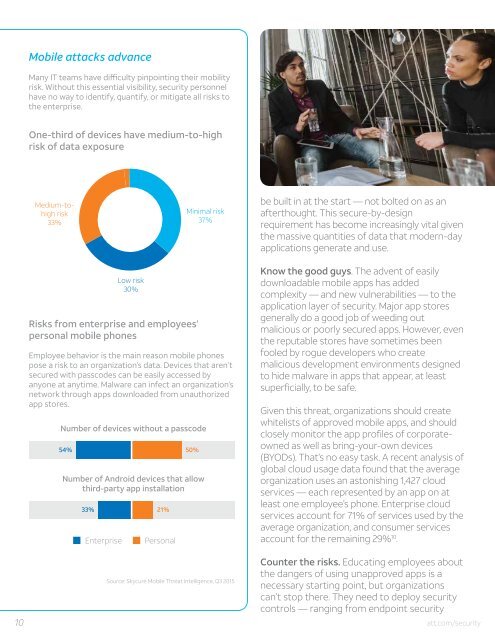The CEO’s Guide to Data Security
2mRmvHx
2mRmvHx
You also want an ePaper? Increase the reach of your titles
YUMPU automatically turns print PDFs into web optimized ePapers that Google loves.
Mobile attacks advance<br />
Many IT teams have difficulty pinpointing their mobility<br />
risk. Without this essential visibility, security personnel<br />
have no way <strong>to</strong> identify, quantify, or mitigate all risks <strong>to</strong><br />
the enterprise.<br />
One-third of devices have medium-<strong>to</strong>-high<br />
risk of data exposure<br />
Medium-<strong>to</strong>high<br />
risk<br />
33%<br />
Minimal risk<br />
37%<br />
be built in at the start — not bolted on as an<br />
afterthought. This secure-by-design<br />
requirement has become increasingly vital given<br />
the massive quantities of data that modern-day<br />
applications generate and use.<br />
10<br />
Low risk<br />
30%<br />
Risks from enterprise and employees’<br />
personal mobile phones<br />
Employee behavior is the main reason mobile phones<br />
pose a risk <strong>to</strong> an organization’s data. Devices that aren’t<br />
secured with passcodes can be easily accessed by<br />
anyone at anytime. Malware can infect an organization’s<br />
network through apps downloaded from unauthorized<br />
app s<strong>to</strong>res.<br />
Number of devices without a passcode<br />
54%<br />
Number of Android devices that allow<br />
third-party app installation<br />
33%<br />
Enterprise<br />
21%<br />
Personal<br />
50%<br />
Source: Skycure Mobile Threat Intelligence, Q3 2015<br />
Know the good guys. <strong>The</strong> advent of easily<br />
downloadable mobile apps has added<br />
complexity — and new vulnerabilities — <strong>to</strong> the<br />
application layer of security. Major app s<strong>to</strong>res<br />
generally do a good job of weeding out<br />
malicious or poorly secured apps. However, even<br />
the reputable s<strong>to</strong>res have sometimes been<br />
fooled by rogue developers who create<br />
malicious development environments designed<br />
<strong>to</strong> hide malware in apps that appear, at least<br />
superficially, <strong>to</strong> be safe.<br />
Given this threat, organizations should create<br />
whitelists of approved mobile apps, and should<br />
closely moni<strong>to</strong>r the app profiles of corporateowned<br />
as well as bring-your-own devices<br />
(BYODs). That’s no easy task. A recent analysis of<br />
global cloud usage data found that the average<br />
organization uses an as<strong>to</strong>nishing 1,427 cloud<br />
services — each represented by an app on at<br />
least one employee’s phone. Enterprise cloud<br />
services account for 71% of services used by the<br />
average organization, and consumer services<br />
account for the remaining 29% 10 .<br />
Counter the risks. Educating employees about<br />
the dangers of using unapproved apps is a<br />
necessary starting point, but organizations<br />
can’t s<strong>to</strong>p there. <strong>The</strong>y need <strong>to</strong> deploy security<br />
controls — ranging from endpoint security<br />
att.com/security



